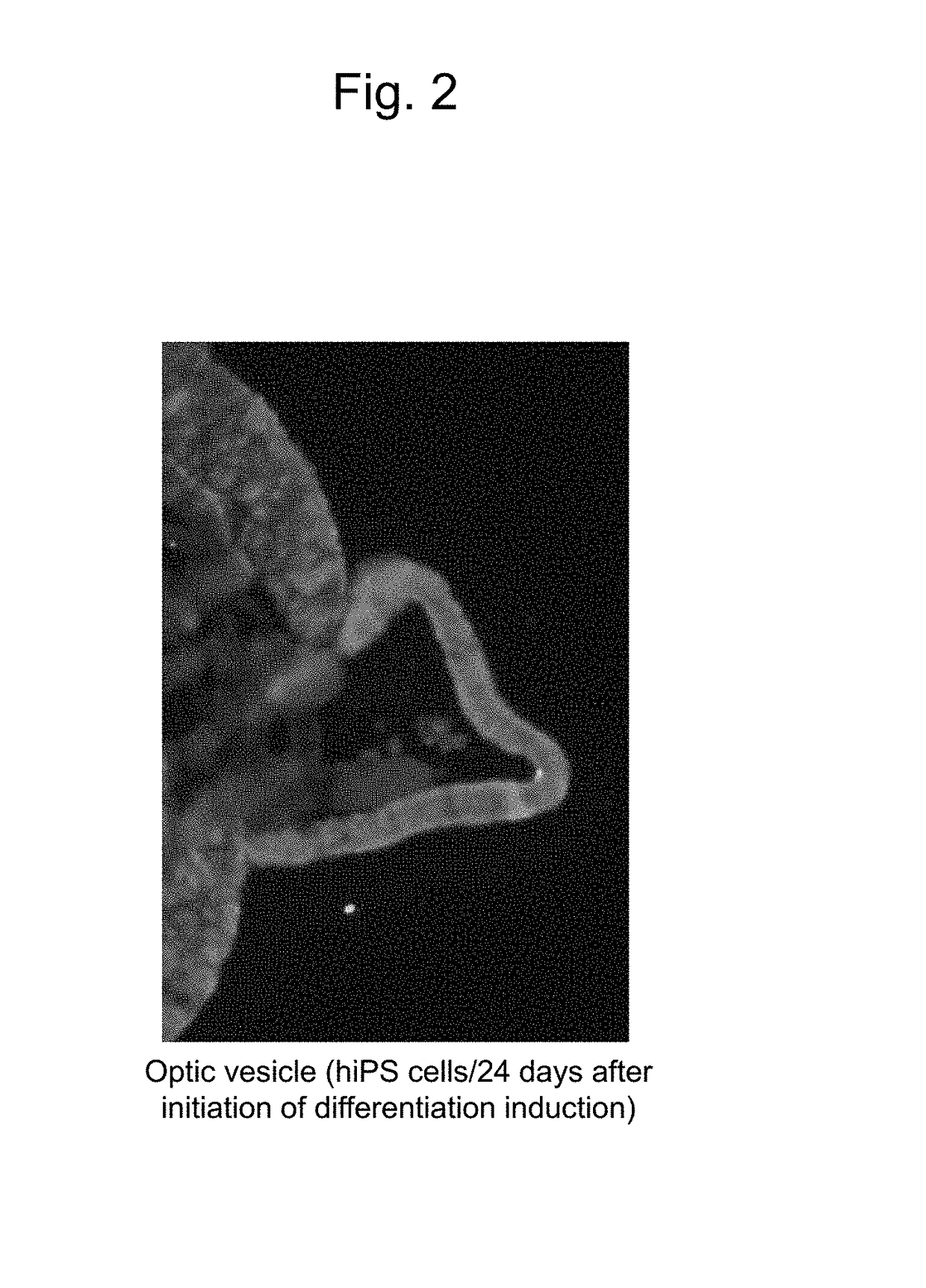Method for preparation of retinal ganglion cells
a retinal ganglion and ganglion cell technology, applied in the field of preparation of retinal ganglion cells, can solve the problems of low possibility of successfully inducing the cellular components of the retina, insufficient lowering of intraocular pressure to stop the progression of glaucoma, and insufficient regenerative of the retinal nerve fiber layer with elongated axons, etc., to achieve no risk of retinal detachment, easy supply, and efficient production
- Summary
- Abstract
- Description
- Claims
- Application Information
AI Technical Summary
Benefits of technology
Problems solved by technology
Method used
Image
Examples
examples
[0108]Hereafter, the present invention is described in greater detail with reference to the examples, although the technical scope of the present invention is not limited to these examples.
(Example 1) Preparation of Retinal Ganglion Cells from Human iPS Cells
1. Method
[0109](1) Induction of Differentiation from Human iPS Cells into Retinal Progenitor Cells
[0110]Human skin-derived iPS cells 409B2 provided by the Riken BioResource Center (RIKEN BRC) were used as human iPS cells (Okita et al., 2011, A more efficient method to generate integration-free human iPS cells, Nat. Methods). Basically, human iPS cells were induced to differentiate into retinal progenitor cells in the manner described below in accordance with the serum-free floating culture of embryoid body-like aggregates with the quick reaggregation (SFEBq) method described in the literature (Nakano, T. et al., Self-formation of optic cups and storable stratified neural retina from human ESCs, Cell Stem Cell 10, 771-785, 2012),...
example 3
(Example 3) Controlled-Release Test of Neural Inhibitor on Retinal Ganglion Cells
[0139]Floating culture was terminated 27 days after the initiation of differentiation induction that was conducted in Example 1, embryoid bodies were transferred and allowed to adhere to a 6-well plate coated with poly-D-lysine and laminin, and adhesion culture was then initiated using a neuronal maintenance medium supplemented with BDNF (final concentration: 100 ng / ml) (GlutaMAX-containing D-MEM / F12, N2 Supplements (Life Technologies), 1% FBS). The nerve growth inhibitor (Semaphorin 3A (SemaA)) was subjected to a controlled-release test 2 days after the initiation of adhesion culture. At the outset, MedGEL SP P15 (MedGEL Corporation) was soaked in 30 μl of 100 μg / μl Sema3A, and it was allowed to stand at 4° C. for 60 minutes. MedGEL was placed on Kimwipes, an excess solution was removed therefrom, and MedGEL was placed in a region approximately 5 mm away from the embryoid bodies. Thereafter, 10 μl of 1...
example 8
(Example 8) Functional Analysis of Axons
(1) Observation of Axonal Flow
(Method)
[0159]RGCs and their axons are known to be rich in mitochondria and to maintain homeostasis by axonal transport, as in other neurons. Neurotrophic tyrosine kinase receptor 1 (NTRK1), a member of the neurotrophic tyrosine kinase receptor family, is a nerve growth factor receptor. It is known to be expressed in RGCs, especially when the cells are damaged.
[0160]Using these two factors; i.e., NTRK1 and mitochondria, as tracers, a plasmid vector composed of GFP-NTRK1 with a CMV promoter and a plasmid vector composed of mCherry-mitochondria with a CMV promoter were directly introduced into the RGC cell body 34 days after the initiation of differentiation induction from human iPS cells (Day 34) via electroporation, and the anterograde rapid axonal transport was analyzed.
[0161]A specific test procedure is described below. The NTRK1 expression vector (RG213091; OriGene Technologies, Inc.), the pPAmCherry-Mito Vecto...
PUM
| Property | Measurement | Unit |
|---|---|---|
| culture temperature | aaaaa | aaaaa |
| culture temperature | aaaaa | aaaaa |
| concentration | aaaaa | aaaaa |
Abstract
Description
Claims
Application Information
 Login to View More
Login to View More - R&D
- Intellectual Property
- Life Sciences
- Materials
- Tech Scout
- Unparalleled Data Quality
- Higher Quality Content
- 60% Fewer Hallucinations
Browse by: Latest US Patents, China's latest patents, Technical Efficacy Thesaurus, Application Domain, Technology Topic, Popular Technical Reports.
© 2025 PatSnap. All rights reserved.Legal|Privacy policy|Modern Slavery Act Transparency Statement|Sitemap|About US| Contact US: help@patsnap.com



